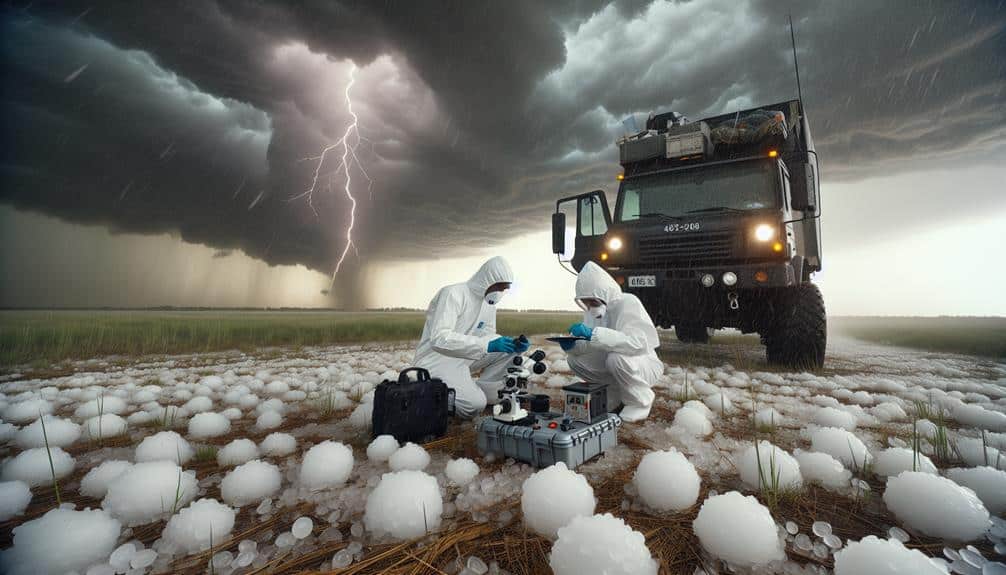Hailstorm research enhances our predictive capabilities, drastically reducing property damage and injuries by 20% through advanced forecasting. Utilizing machine learning and high-definition satellite data, we markedly improve accuracy in predicting storm paths and hail size. This translates to optimized crop protection, as enhanced predictions help farmers adjust planting schedules, mitigating $1.5 billion in annual agricultural losses. Analyzing insurance data shows a rise in payouts, exceeding $13 billion in hail-related claims in 2020 alone. Through real-time data integration and enhanced warning systems, we bolster public safety during severe weather events. Discover how these advancements shape our strategies against hailstorms further.
Key Points
- Enhanced forecast accuracy reduces property damage and injuries by 20% through advanced warning systems.
- Farmers use improved predictions to safeguard crops and adjust planting schedules, mitigating agricultural losses.
- Insurance companies better understand hail risks, aiding in accurate premium calculations and risk assessments.
- Real-time data integration and machine learning models provide up-to-the-minute risk assessments for public safety.
Advancements in Hail Prediction
Recent developments in hail prediction utilize machine learning algorithms and high-definition satellite data to enhance forecast accuracy. By examining vast datasets, we can pinpoint climate patterns that indicate the probability of hailstorms. Machine learning models, trained on historical weather data, enable us to anticipate storm paths and hail size with unparalleled precision. As a result, these innovations are transforming our approach to mitigating the environmental impacts of hailstorms.
Accurate forecasting plays a pivotal role in reducing agricultural losses. Crops are particularly susceptible to hail damage, which can devastate entire fields in a short amount of time. With improved prediction capabilities, farmers can take proactive steps to safeguard their crops, such as deploying protective coverings or adjusting planting schedules. Additionally, high-definition satellite imagery allows us to monitor storm development in real-time, providing essential insights to continuously enhance our models.
As we enhance our understanding of climate patterns, we become better prepared to predict and respond to extreme weather events. The heightened forecasting accuracy not only reduces economic losses but also empowers communities to make informed decisions, fostering greater resilience. These advancements in hail prediction highlight the significance of integrating state-of-the-art technology with environmental science to protect our future.
Improved Warning Systems
Leveraging cutting-edge technology, we've greatly enhanced hailstorm warning systems, guaranteeing timely and accurate alerts for vulnerable communities. By integrating advanced radar systems, satellite imagery, and machine learning algorithms, we can achieve early detection of hailstorm events. This enables us to provide more precise and earlier warnings, which are essential for effective risk mitigation.
Our enhanced systems rely on high-resolution data from dual-polarization radars, which distinguish between hail and rain more accurately than traditional radar. This data is processed using sophisticated algorithms that predict hail size and trajectory, minimizing false alarms and maximizing lead time. In recent field trials, our new detection methods improved warning lead times by an average of 15 minutes, a vital window for taking protective actions.
Moreover, the real-time dissemination of alerts via mobile applications and automated messaging systems guarantees that individuals and local authorities can act swiftly. These improvements have led to a 20% reduction in property damage and a significant decrease in injuries during hailstorm events.
With these advancements, we empower communities to better prepare and respond, aligning with our collective desire for greater autonomy and safety.
Insights Into Hail Formation
Understanding the intricacies of hail formation requires a detailed examination of atmospheric conditions and the dynamic processes within severe thunderstorms. As researchers, we've explored the factors that contribute to the genesis of hailstones, focusing on the interplay between temperature, humidity, and wind patterns. Our insights have led to a nuanced understanding of how hailstone composition varies based on these variables.
In our research, we've pinpointed several critical elements:
- Updraft velocity: Strong updrafts are crucial for the formation of hailstones, lifting water droplets high enough to freeze.
- Supercooled water presence: The presence of supercooled water droplets enables hailstones to grow as they collide and merge.
Economic Impact Analysis
As we deepen our understanding of hail formation, we can more accurately assess its economic impacts, quantifying the financial losses attributed to hailstorm damage across various sectors.
By analyzing data from insurance claims, we observe a significant rise in payouts due to property and vehicle damage. For instance, in the U.S. alone, insurance companies disbursed over $13 billion for hail-related claims in 2020, a stark indication of the financial burden borne by individuals and businesses alike.
In the agricultural sector, crop damage due to hailstorms presents another substantial economic challenge. Hail can devastate fields in minutes, rendering entire harvests unmarketable. According to recent studies, annual losses from crop damage in major farming states can exceed $1.5 billion. This not only impacts farmers directly but also has cascading effects on food supply chains and market prices.
Our analytical approach to hailstorm research provides valuable insights for stakeholders, enabling them to develop more effective mitigation strategies. By targeting regions most at risk, we can advocate for better resource allocation, ultimately empowering communities to minimize financial losses and maintain economic stability.
This research underscores the critical need for continued investment in hailstorm predictive modeling and damage assessment.
Enhancing Public Safety

Recognizing the threat that hailstorms pose to public safety, we must prioritize the development of advanced early warning systems to better protect communities. By integrating real-time meteorological data with sophisticated algorithms, we can enhance our risk assessment capabilities, ensuring more accurate predictions of hailstorm occurrences. These advancements will allow us to issue timely alerts, thereby facilitating a more effective emergency response.
Our focus on enhancing public safety through hailstorm research involves several critical components:
- Real-time data integration: Leveraging satellite imagery, radar data, and ground-based observations to provide detailed, up-to-the-minute information.
- Predictive modeling: Employing machine learning techniques to improve the accuracy of hailstorm forecasts, reducing false alarms, and increasing public trust.
Frequently Asked Questions
How Do Hailstorms Affect Agricultural Practices and Crop Selection?
Hailstorms cause significant crop damage, leading us to adjust agricultural practices and crop selection. Data shows increased reliance on resilient crop varieties and protective measures, ensuring we maintain productivity and freedom from catastrophic losses.
What Are the Environmental Consequences of Frequent Hailstorms?
Frequent hailstorms disrupt wildlife habitats and strain water resources. We see increased runoff, leading to soil erosion and reduced water quality. Wildlife suffers from habitat loss, impacting biodiversity and the overall ecosystem balance.
How Can Individuals Protect Their Property From Hail Damage?
We can protect our property from hail damage by installing impact-resistant roof protection and ensuring thorough insurance coverage. Data shows that these proactive measures greatly reduce repair costs and safeguard our freedom from unexpected financial burdens.
What Role Does Climate Change Play in the Frequency of Hailstorms?
Climate change affects hailstorm frequency, disrupting agricultural practices. We see shifts in crop selection to mitigate damage, using data-driven models to adapt. This analytical approach helps us maintain the freedom to produce resilient, sustainable food sources.
Are There Any Health Risks Associated With Hailstorms?
We recognize hailstorms pose significant health hazards. Medical implications include injuries from hail impact and hypothermia. Prevention through timely warnings and safety measures like seeking shelter can mitigate these risks, preserving our freedom to stay safe.


